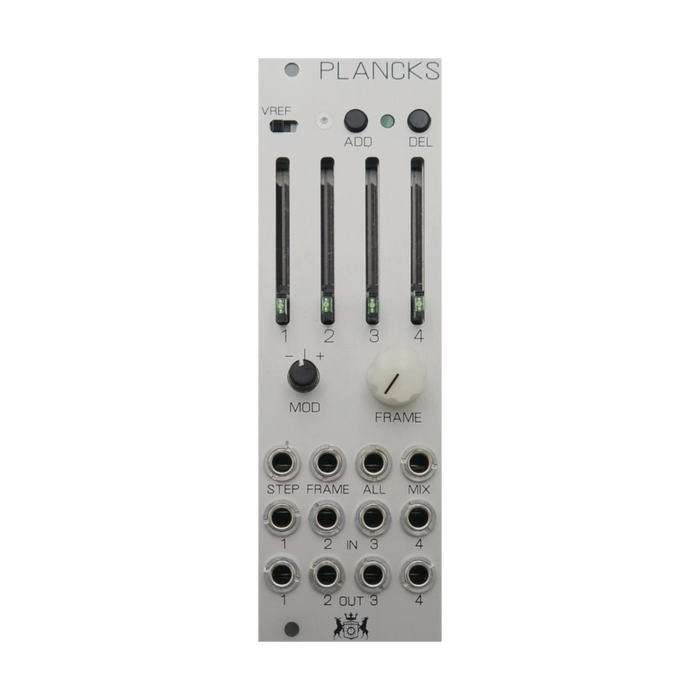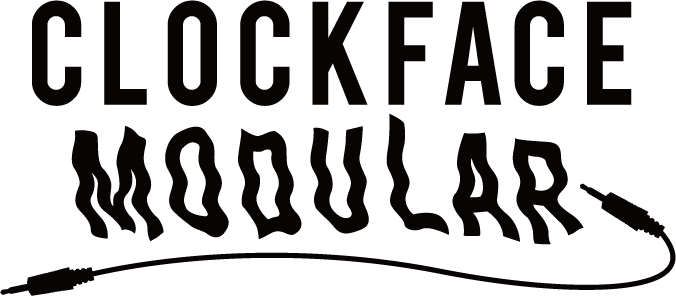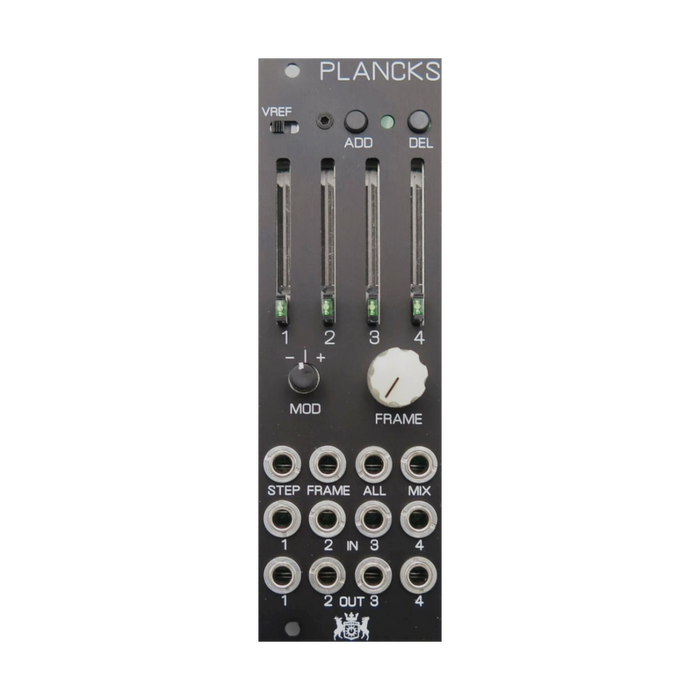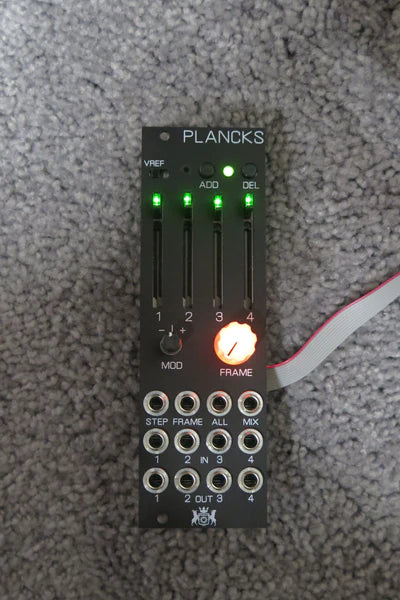MUSICAL FEATURES
Plancks IIMutable Instruments FramesThis is a signal processor that has been cloned and compacted to 8HP. The original firmware has been further improved.ParasietesFirmware v1.1 is preinstalled.
PARASITES FIRMWARE
Parasites firmware has 5 modes to choose from, including the original keyframer mode. To switch between modes, press the two buttons, then select the mode by moving the slider or Frame knob control. Press the button again to confirm the mode. The controls to be moved and the modes to be selected are as follows.
- Frame knob: Selects the original key framer mode.
- Slider 1...Quad sequencer mode
- Slider 2...Shift register sequencer mode
- Slider 3: Quad LFO mode (compatible with original firmware Easter Egg mode)
- Slider 4...Euclidean sequencer mode
HOW TO USE
The explanation of each mode is as follows. Depending on the mode, FRAME CV in is used as a clock input, in which case make sure to turn the MOD knob fully clockwise to avoid attenuating the incoming clock signal.
keyframer mode
This is the original keyframer mode.You can specify the gain level for each channel using the top four knobs and sequence/morph between the memorized settings using the Frame knob.You can add/delete frames using the ADD/DEL buttons.
There are up to 64 presets for gain level settings (Key frame). Then, use the large "Frame" knob in the center and CV to move between keyframes and change (animate) the four gains. There are 1 types of transition characteristics between frames, which can be selected for each channel by pressing and holding the Add button for 4 second and then turning the gain knob.
Channels that are not patched to individual channel input jacks will share the signal from the ALL input with their input. Furthermore, if nothing is patched to the ALL input, turning on the "VREF" switch will route a constant 10V voltage to that channel as an input.
Each channel's input signal passes through each channel's attenuator to the output. If it is patched to an individual channel's output jack, the signal will be output there, otherwise it will be output from the MIX output. If there are similar channels, the outputs of those channels will be mixed and output from the MIX output, making it a mixer.
About keyframe modeOriginal Frames descriptionSee also
Quad sequencer mode
This mode switches the number of frames created as the number of steps without interpolating between key frames like a sequencer.
Use the FRAME knob to select frames to edit using faders 1 to 4, and add/delete frames using the ADD/DEL buttons.
To enter step editing mode to adjust the value of the current step, press and hold the DEL button until the FRAME LED lights dimly, and to exit, press the DEL button briefly. When in step editing mode, the FRAME knob sets the number of steps in the sequence that will be played; when turned fully clockwise, the sequence will play using all steps, and when turned fully counterclockwise, the FRAME knob will set the number of steps in the sequence that will be played. Only the steps will be played repeatedly. Frames (steps) cannot be added or deleted in step edit mode.
A long press of the ADD button will randomize all values of the current sequence.
*The VCA that controls the gain of each channel is affected by temperature changes, and the output CV may be distorted.
Shift register mode
In this mode, you enter a sequence of fader values in the same way as in keyframer/quad sequencer mode, but only the sequence for channel 1 is used, and channels 2 to 4 are shift registers where the values of channel 1 are output with a shift of each clock. This will be the output.
FRAME CV in acts as a clock input and the following two events occur:
- The sequence advances one step.
- In steps 2 to 4, the value of channel 1 is shifted to the right in order, and the value of channel 4 is shifted back to 1. (shift register)
What is the Planck's shift register clock for a sequence of frames?anotherYou can advance by the number of divisions or skips, allowing you to create unique CV sequences. Specify them using faders 2-4 as shown below.
- Fader 2 divides and skips the clock that advances the steps. When the fader is set below center, it functions as a 1/1 to 1/8 clock divider. If you set the fader above the center, the step progression will be randomly skipped.
- Fader 3 advances the shift register
Divide and skip against the clockto hold.
- Fader 4 sets the shift back error amount and shift order shuffle.
Outputs a short trigger from the STEP out when either a sequence of frames or a sequence of shift registers occurs. The FRAME knob selects the frame and sets the number of looped frames for channels 2-4.
Quad LFO mode
In this mode, the gain of each channel is controlled by the LFO. When outputting 4 LFOs, we recommend enabling the VREF switch and not patching cables to channels 1-4 and ALL in.
The FRAME knob sets the main frequency of the LFO along with the CV input.
Fader 1 sets the LFO waveform and selects it while morphing the built-in wavetable.
Fader 2 sets the difference in wavetable readout position between each channel. At the center position, all channels output the same waveform, and when moved up or down, each channel reads a different waveform from the wavetable.
Fader 3 sets the phase difference or frequency offset for each channel. At the center position, all channels have the same phase and frequency; moving it up shifts the phase between channels; moving it down shifts the frequency.
Fader 4 sets the phase modulation between each channel. In the center position, all channels are independent; moving up modulates each channel by the next channel; moving down modulates the previous channel.
Pressing the ADD button will reset the phase of all LFOs.
Pressing the DEL button will randomly change the phase of all LFOs.
STEP out goes high for half a cycle on channel 1.
Euclidean sequencer mode
In this mode, you can set the Euclidean sequence Fill and Length (maximum 16 steps) for each channel, and control the gain of each channel using an envelope whose shape can be changed.
FRAME CV in functions as a clock input.
Each fader sets the Fill from 0 to the Length number, and the FRAME knob sets the Rotate between the four channels.
If you press and hold the ADD button, you can set the length of each channel in the range of 1 to 4 using faders 1 to 16, and you can exit the length setting mode by pressing either button briefly.
If you press and hold the DELL button, you can change the envelope shape of each channel using faders 1 to 4. The fader has a short decay when it is at its lowest position, a longer decay when it is in the center, and a triangle shape when it is at its highest position. A short press of either button will exit envelope setting mode.
STEP output outputs the combined gate of each channel's status, and the FRAME LED lights up at the corresponding timing.







